I wrote this ten years ago, the year I injured myself playing Norm Abram and almost cut a few fingers off my right hand. I wanted to revisit this after ten years because my hand has been aching lately, and I think I’m starting to get the carpal tunnel syndrome a physician friend told me was pretty much inevitable. So I’ve been thinking about it a lot. Here ya go.
—–
The icy wind bullied its way through the leafless trees and hit my chest like a clenched fist, sucking heat from my hands, twisting my paddle in my hand and sending a nice, misty spray of cold river water over the bow.
“Better to be on shore wishing you were out there in the storm, than out there in the storm wishing you were on shore.” The words of my friend Max Finkelstein, a veteran of thousands of miles of canoe trips (most of them solo), were echoing in that empty space between my ears. That’s where my brain would have been if I hadn’t left it on the sand bar next to the campfire earlier than morning. Cold does strange things to a man’s senses and makes one forget one’s brain.
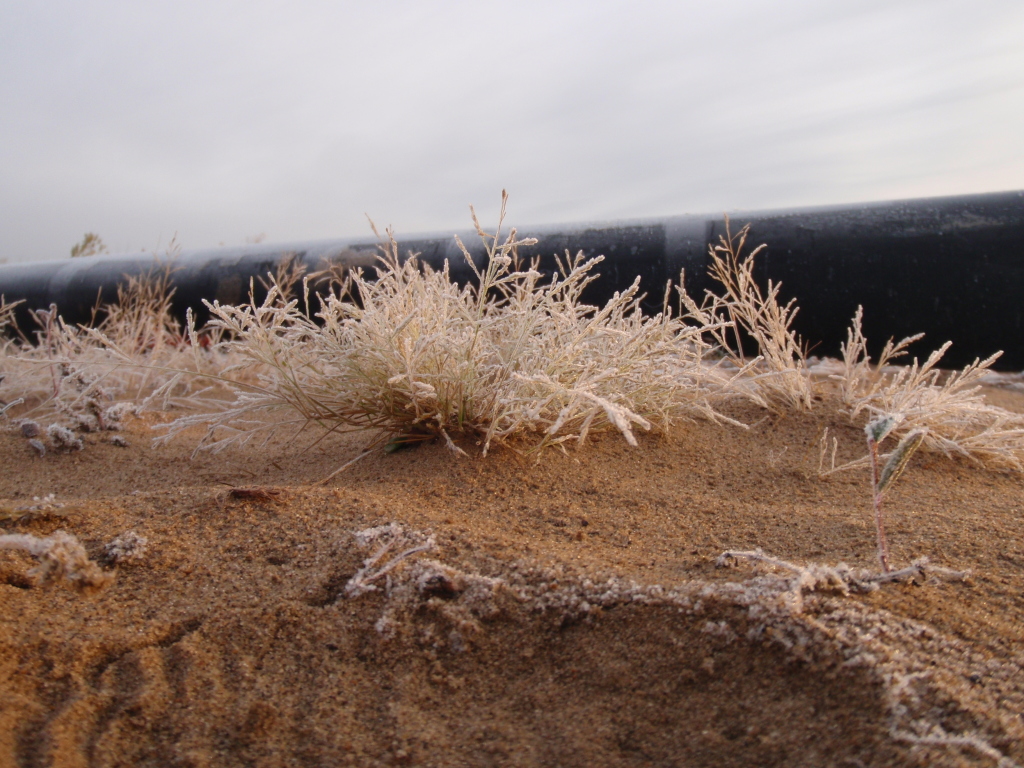
I was on the Wisconsin River in late October as part of a pact I had made with myself last year. “One solo canoe trip each quarter. Two days at least, three is better.” I had managed to do three out of four, and batting .750 isn’t too bad, all things considered. Especially with one thing considered.
On March 5, 2004, I was working late into the evening in my garage workshop a week before Canoecopia. I would have a full house in a few days, and one shower and eleven people wouldn’t cut it; I had to finish the shower enclosure in our bathroom. I was tired.
At 9:30, I was ripping a piece of cedar on the table saw, with the guard off. No lectures please, I’ve endured enough of them, believe me. The blade was set high and close to the fence, but the supposed “clear” cedar had a knot in it, and the piece I was cutting was not cooperating, binding between the fence and the blade. I can’t say how it happened, but I was out of position and out of balance, and as I pivoted on my foot to turn off the saw, I found myself staring at my own right hand, a deep cut across all four fingers and my palm. It was surreal, but the pain soon brought me back to the reality of the situation; I let out a wild yell of agony and ran through the kitchen door into the house.
“Honey, please call 911. This is a bad one.” As Stephanie grabbed the phone, I snatched up a clean dishcloth and did the best I could to slow the bleeding while sirens approached the house. Fortunately the arteries were intact, but I would soon find that the veins, nerves, and tendons were cut on all four fingers. The paramedics asked where I wanted to go. “I’d like to see the best hand surgeon in Wisconsin, please.” Seconds later I was on my way to University Hospital.
After two surgeries, 59 appointments at the hand clinic and countless hours of rehab, the miracle is that I am able to type. Once again I can use my own seven-finger method, the same method I used long before my accident. It’s not 100%, and it never will be, but I have four pink, wiggly fingers where I could have had nothing. Many of my fellow clinic visitors have not been as fortunate. While my hand has some wicked scars, (a friend once called it Frankenfist), it mostly works.
The table saw accident changed my life in a profound way, which was reflected in the trips I did (and didn’t make). It has been a long, painful, yet insightful year. So now with that background, I’m here to report on my solo trip resolution.
First Quarter
Date reserved for paddling: March 26-28
River visited: yeah, right
Miles paddled: 0
Eighteen days after surgery, I was in no condition to go anywhere. I was under strict orders to keep my hand immobilized or risk rupturing a tendon, and then I’d really be in for it. One time I tried putting an Ace bandage around my hand, the splint, and the paddle shaft, and I paddled a few hundred feet behind Rutabaga, but it was just too painful. And in retrospect, incredibly stupid. Some would ask why I would try in the first place, and the only answer is, well, it’s a canoeing thing. At any rate, I did it, and it hurt like hell, and I didn’t try it again.
I have no idea how people become addicted to painkillers. I hated how they made me feel – totally disconnected from my body. True, you can’t feel much pain, but you can’t feel much of anything else either. That’s just not my cup of Vicodin.
I admit that I fell into a severe funk as the dates I had set aside approached and passed, and I remember thinking, “This is going to be a hard season.” I had no idea.
What I learned: I lacked patience and the ability to accept limitations, until pain and physical impossibility gave me the smack-down. Wanting what you can’t have just hurts. Letting go of an impossibility is not pleasant, but necessary now and then. The River will still be there, waiting for me, when I am healed.
Second Quarter
Dates reserved for paddling: May 20-22
River visited: Lower Wisconsin
Miles paddled: Over 40
The water was up, and we were moving four miles per hour without paddling a stroke. I say “we” because my solo trip turned tandem.
It was a little over two months after surgery and I was still tender, but at least not bandaged or even worse, splinted. I still had Frankenfist, but it moved like a hand in some ways, though I lacked significant grip strength.
I could have taken a solo trip, but I could tell Stephanie was worried, because she said “Darren, I’m worried about you going on a solo trip so soon.” Call it Male Intuition. Now the choices were to go on the trip, while Stephanie worries– not a desirable outcome. Or stay home, and another opportunity slips by; equally undesirable.
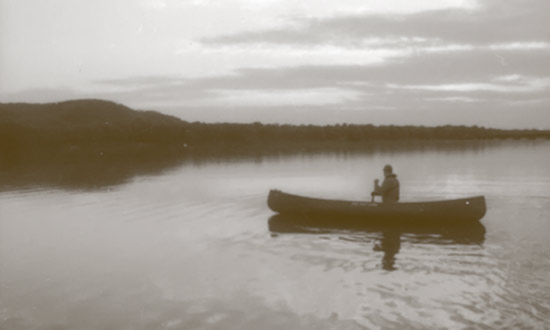
First solo picture of me that year. Larry took it.
It was my friend Kaitlyn who nudged me out of my either/or mindset.
“Hey, dummy, who says you have to go solo?”
“I do. It’s a solo trip. From the Latin solus. It means ‘alone’, get it?”
“Yeah, I know. But you don’t have to go solo.”
“Yes, I do.”
“No…you…don’t.”
“Okay, fine. Who would want to drag a one-handed guy down the River?”
“Let me think about it….oh, I can think of about a hundred people.”
“But I don’t want to go tandem,” I whined.
She considered this statement for a moment, then responded calmly.
“Fine. Stay home then.”
I love it when she’s right.
I considered my options, and I decided to call my friend Larry. He could use a good paddle, so I called and asked him if he “would be willing to drag my sorry, one-handed carcass down the Wisconsin River for a few days.”
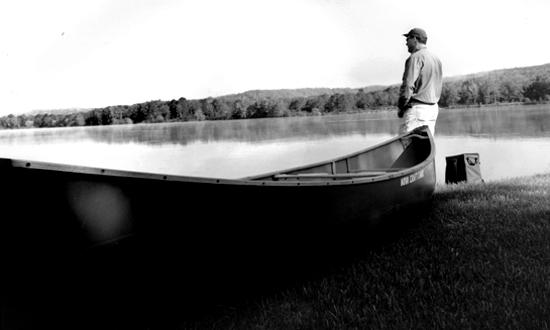
Waiting to put in. Taken by Jim who ran our shuttle.
His answer was a gift. “Darren, not only would I be willing, I would be honored.” Honored? Wow.
Once I started thinking tandem trip, the disappointment of losing solitude was quickly replaced by the thought of Larry’s company. Larry has the Alabamian gift of gab, which is to say that almost everything he says is funny due to content, delivery, or both. For instance, Larry’s personal lexicon states that one does not simply die, one “achieves room temperature.”
Because the water was over the banks and moving fast, we ran out of river before we ran out of time. We went home a day early, but not before enjoying some glorious adventures, exploring places normally not accessible at low water. Along the way we ate great food; lox, homemade granola, gingersnaps (of course), good lamb, lots of fruit, excellent hot tea, the works. We found Wilson the football, a raccoon skull, a turtle shell, and exactly one campsite big enough for our tent. I also found a deeper friendship.
What I learned: It’s okay to change your plans, even at the last minute. Good friends will always come through for you. Patience again. Letting people do things for you is hard if you’re independent. I’m too independent.
Third Quarter
Dates reserved for paddling: September 17-18
River visited: Pecatonica
Miles paddled: I didn’t measure. About 12, maybe.
It was my first solo trip “for real” since my accident. Now Stephanie wasn’t worried, but I was. I was driving to the Wisconsin River and noticed all the trees were bending steadily away from the direction I wanted to go. I detoured and headed south and west. I had no idea where I would end up.
The Pecatonica is a muddy little stream that runs through a beautiful stretch of Iowa and Grant counties. It is not beautiful with a capital B (we reserve that for places like the Namekagon or the Bois Brule), but it is a most pleasant place to paddle. Moreover, it’s down in a bit of a depression so the wind might blow, but by the time it negotiates the stream bank it’s pretty calm down there. The downside is that the high banks sometimes limit the access to scenery. In this case, it was worth the tradeoff. It was go small or go home.
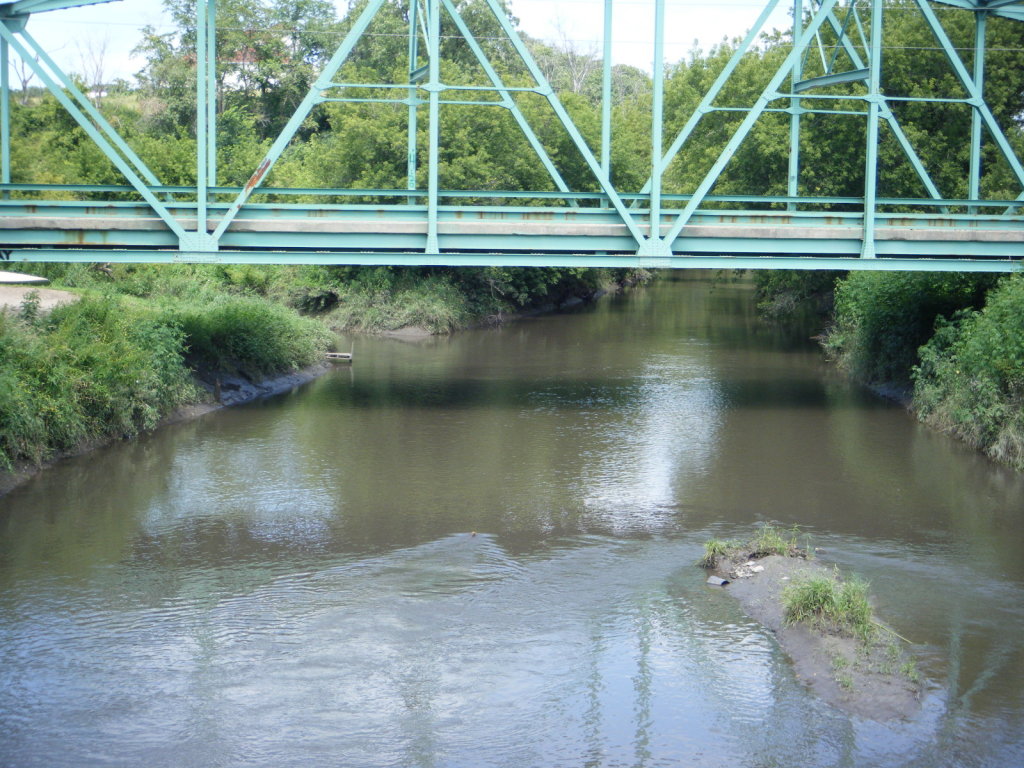
Since I was alone, I brought my bike, which I would use to shuttle between my car and my canoe. Thankfully, a bike path ran along the river between the put-in and Darlington. The shuttle was as enjoyable as the paddle. The washboard-like Cheese Country bike trail challenged my hand a little, but if I slowed down the bumps and jars were acceptably minimized. The trail ran along the river in spots, giving me a quick taste of what was to come. Rather than barreling down the trail at “get it over with” speed, I had to ride slowly, like a mogul skier, picking my way through the bumps.
I wanted to make this river last a while. I chained my bike up under the bridge, launched down a muddy slide that had previously seen canoe action and deliberately took a pace that would be just a bit slower than usual.
The sunlight filtered through the trees, creating a green cathedral. A few trees were starting to turn, but the majority of the silver maples and cottonwoods were still bright green. I had brought only black-and-white film, so instead of shooting off pictures I would later toss into the trash, I just took the time and observed and absorbed. I could have spent some time shooting but I was enjoying being there instead of recording there. I don’t need a picture of that day, I can feel it, smell it, and see it whenever I want to. I did this for several hours.
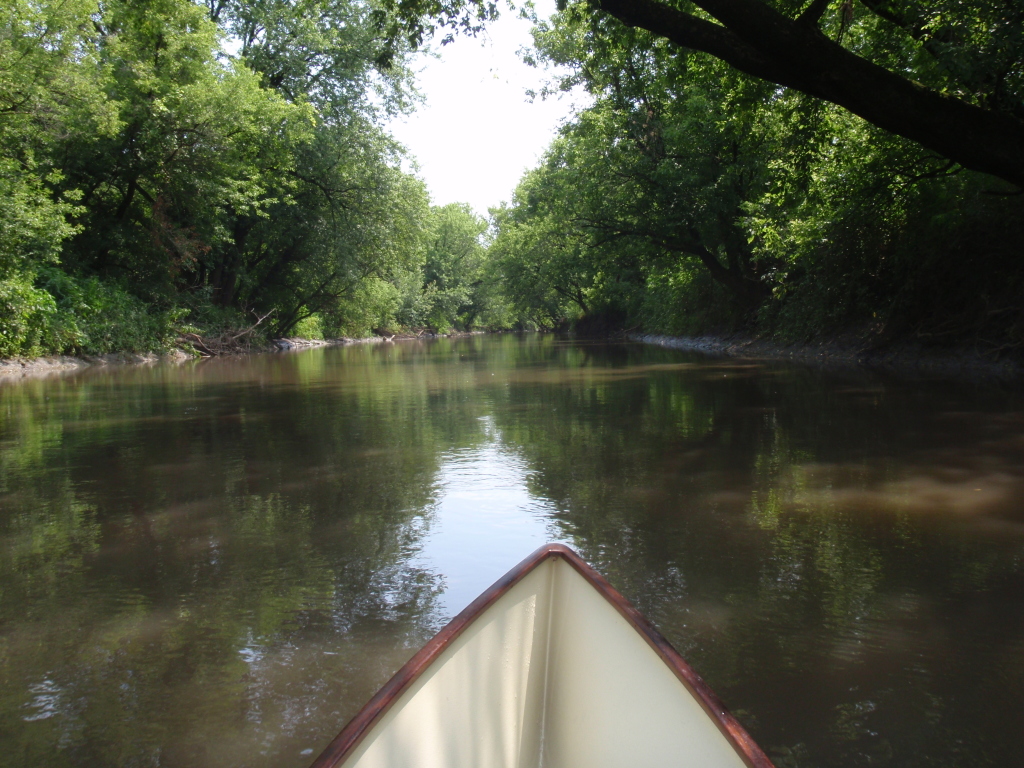
As the city came into view I realized I had taken much longer than I had planned to paddle that stretch. I felt lazy, and it felt good to feel lazy. It was as I loaded up my canoe on the car that I realized I was hungry, and hungry in that vicinity meant Cornish food.
Mineral Point is an enclave of Cornwall, no question about that. The Red Rooster serves a great pasty, a sort of meat pie that miners would take down into the mines for their supper. Lard, meat, onions, flour, and rutabagas or turnips are pretty much all you need, but getting it in the right proportions is an exact science. I gained back all the weight I had lost on the paddle and ride. It was a fair exchange.
What I learned: Slow down. Don’t stubbornly stick to a plan when it no longer makes sense. Slow down even more. Observe and absorb more; take fewer pictures. The Red Rooster in Mineral Point is a fine institution.
Fourth Quarter
Dates reserved for paddling: October 23-24
River visited: Lower Wisconsin
Miles paddled: 24
One of the advantages of late fall paddling is that you will almost never see another person out on the water. The wave runners have been rusting quietly for months now, and many casual anglers are put off by cold weather. Solitude!
I had packed my winter bag, good to twenty below, which was a bit much. But better to overkill than to be overkilled. No bugs meant no tent was necessary, just a Whelen lean-to, a modified canvas tarp that is perfect for fall canoe camping.
With just a small (theoretically) smokeless fire in front of it, the Whelen becomes a giant reflector oven, baking the occupant with a luxurious heat, allowing indifference to the frigid gusts that play just inches beyond the edge of the creamy white canvas.
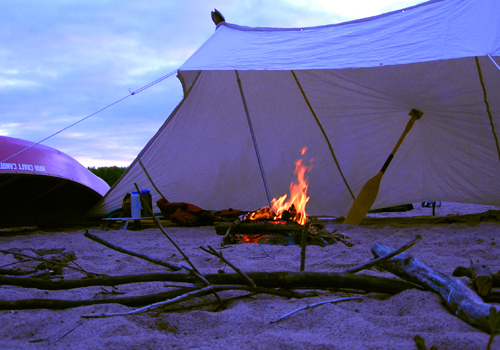
I had paddled most of a glorious fall day. The clouds were out in force but the sun peeked through at times, illuminating the bluffs in all their splendid fall color.
The circulation in my hand is still a bit woofy, and keeping it warm was a major accomplishment, but it was also a blessing. I had to stop fairly often to strip off my gloves and reheat my hand against bare skin, so I had a built-in excuse to poke around.
Poking around sandbars and walking the shoreline produced a personal record of four turtle shells, one of them in perfect condition. I usually have good turtle shell karma, but four in one trip? I was dumbfounded. I also walked a great deal along the edge of the islands where the sand was perfect for capturing tracks of animals, and saw evidence of abundant bird life. Heron tracks are my favorite, big three-toed claws that look like a peace sign without the circle drawn around it. I took a stick and transformed some of the better tracks into heron peace signs and moved on.
Eventually I knew I would have to stop, and the wind was starting to pick up a bit, so I picked a campsite on the downstream side of an island. It wasn’t optimal for weather protection but it had a great view, so I decided I’d make camp, pitching the Whelen first. Once I had it staked down, the wind started blowing in earnest, and it was clear a long, cold blustery night was in store. I buttoned things down, ate a good supper of lamb steak and apples and cheese, polished off the hot chocolate and went to bed at 7:30. It was already black as pitch, and steady drizzle saturated the canvas so it swelled up good and tight. I would sleep dry that night.
The next morning I was up before light to eat and take advantage of the lull in the wind. I dug out the lean-to, the edges partially buried by blowing sand, broke camp in record time, despite the three primes necessary to start my stove. The canvas was crunchy and stiff, and I worried about keeping my hand warm. There was a lot of frost everywhere.
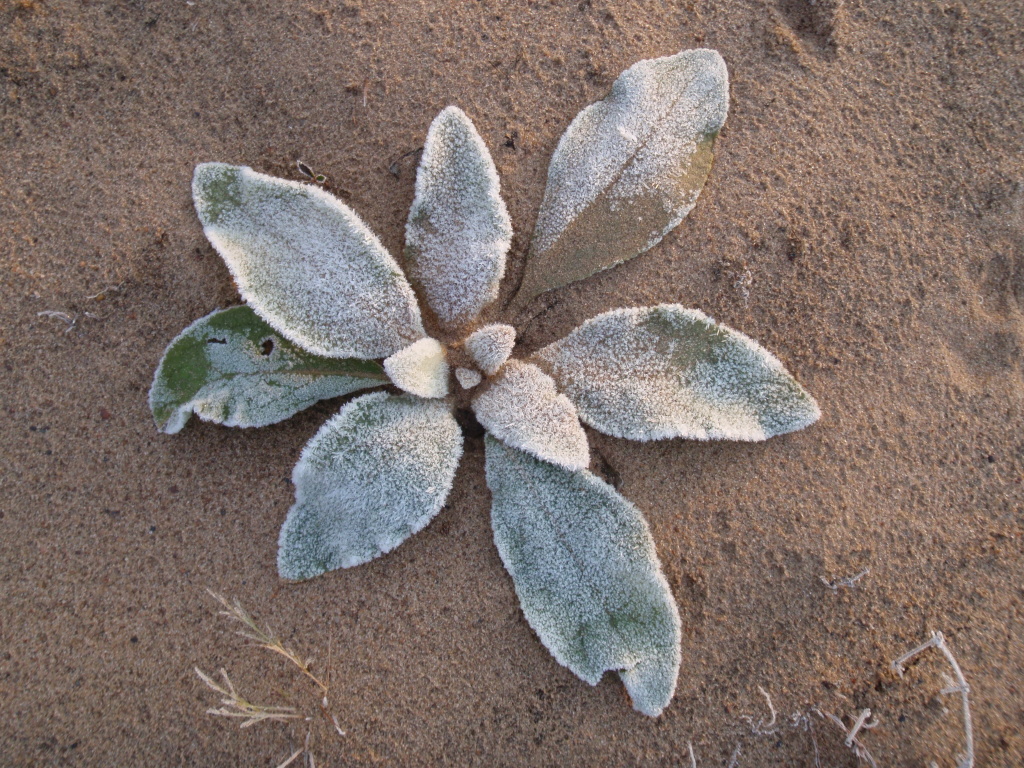
As I paddled down toward Boscobel, the wind intensified, and whitecaps appeared on the surface of the river. I checked my maps and it was still over twenty miles down to the car. Muscoda was about four miles away, but the car was at Boscobel.
The GPS I carry mostly for fun actually came in useful. I learned that I was paddling hard with a full load and making a good 1.3 miles per hour, stopping if I stopped paddling. With delays every half-hour for hand warming, that would make for a very long, cold, potentially dangerous day.
I stopped just upstream of Muscoda in a small, protected cove and lit a small fire while thinking about my options. Watching the whitecaps move upstream, it was an easy decision. I called my wife and told her I was cold and getting colder, and I had taken waves over the bow of the canoe.
Stephanie told me she had just been hoping that I would make wise decisions. She checked the weather report, which showed 35 mile-per-hour winds gusting to 40 from the west, straight up the river. I said I would meet her at Muscoda in about an hour and a half, said our good-byes and put out the fire.
The wind, if anything, had intensified and cautiously I picked my way along the shore, trying to stay in water that was deep enough to float me but still take advantage of the tree cover. It took me an hour to get to the take-out, and I was already bone tired…seventeen more miles would have been too much.
I lit the stove in the shelter of my canoe and waited for water to boil. Looking downstream, I saw whitecaps moving upstream against the current and leaves were being stripped off the oaks in the park next to the take-out. I involuntarily shuddered. “You were right, Max. I’m really glad I’m here.”
What I learned: Sometimes stupidity masquerades as perseverance. If you ask for help, you’ll usually get it, but it might take a while. A wife would rather drive four hours than worry for twelve. Warm wet feet are better than cold wet feet.
And finally, if you almost cut your hand off, it’s not the end of the world. It’s just the beginning of different one.
This story is dedicated to Judi Neumann and all the great staff at the Occupational Therapy Hand Clinic at the University of Wisconsin Hospital, and also to my fellow patients, many with injuries far more serious than mine. Thanks also to Dr. Karol Gutowski, a skilled hand surgeon (twice!) and a gentleman.
